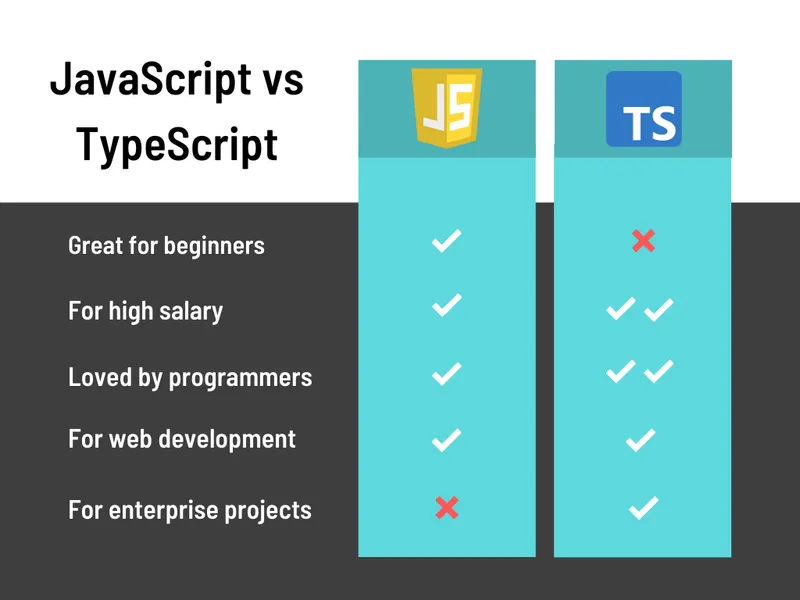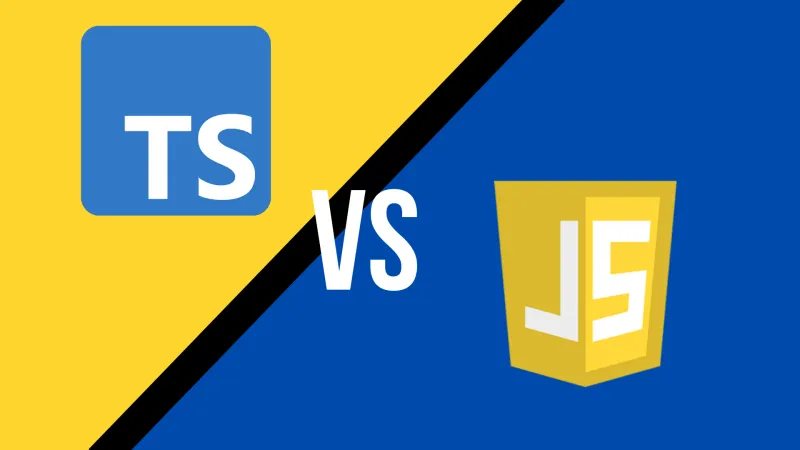Whether you’re new or old to the computer science community, you’ve probably asked yourself, “What is TypeScript?” and if you haven’t, it won’t be long before you do.
However, that question then always leads to, “but wait, what’s the difference between TypeScript and JavaScript?” – so allow me to explain.
JavaScript (JS) is arguably a household name with how popular the language has been from the start. Released in 1995, it’s a high-level, dynamically typed, multiparadigm programming language developed by Brenden Eich at Netscape. JavaScript is one of the core technologies behind the World Wide Web and web browser development, alongside HTML and CSS.
JavaScript is mostly known for its front-end web development and creating dynamic web pages, but it’s also prominently used for desktop applications, web applications, and even artificial intelligence.
TypeScript (TS), on the other hand, is a JavaScript superset. It’s mostly JavaScript, just with static typing and truer object-oriented programming, although it’s multiparadigm as well. It does compile into JavaScript, so it’s a language that depends on JavaScript underneath.
In a turn of events, TS was actually released by Microsoft in 2012, and was developed to address shortcomings in JavaScript’s design. It’s used in the same fields as JS for front-end and back-end web development.
If you’re interested in learning more, then stay tuned to find out which language is best. I’ll start by naming which language is best for beginners, then compare salary, performance, and which is best suited for web development, enterprise projects, and you!

TypeScript vs JavaScript for Beginners 🔗
When choosing a beginner language, you want something that’s easy to pick up because the faster you learn the language, the quicker you’ll get a job.
JavaScript is easy for anyone to grasp, whether you are new to the industry or have some experience. It’s significantly easier than C languages and sits just behind Python in terms of the learning curve.
As a high-level dynamically typed language, it offers a flexible and forgiving environment for writing code and script, and it’s a lightweight language so you won’t get bogged down by excess syntax and features.
Along with being easy to learn, JavaScript is the top language developers are invited to test on via formal recruiting processes, and it remains one of the most sought-after languages by companies, with 72% of them looking for JS developers.
JavaScript is one of the original languages for front-end development, so you’re joining a huge community of developers and tools that offer amazing support.
Oppositely, TypeScript is recommended as a second language.
It has a steeper learning curve and a strict set of rules. Because TypeScript is a superset of JavaScript, it makes sense to learn JavaScript first, then tackle TypeScript once you understand the basics.
Overall, JavaScript is the best for beginners, but the best route is to learn both. If you already have some coding skills but want to further improve, our Functional Programming course teaches JavaScript and PureScript. If you haven’t heard of PureScript before, here’s a quick comparison with TypeScript:
TypeScript vs PureScript: A Mini Comparison 🔗
| PureScript | TypeScript |
|---|---|
| Purely Functional | Object-oriented / Multi-paradigm |
| Reads like Haskell | Reads like C |
| Statically typed | Statically typed |
| Compiled to JS | Compiled to JS |
Like TypeScript, PureScript offers a stricter variation of JavaScript, except this time it’s purely functional, doesn’t support OOP, and looks like the Haskell language. PureScript was developed after poor attempts to compile Haskell to JavaScript, therefore it has a close syntax to Haskell.
As a functional programming language, PureScript uses pure functions to express logic. Many languages use functions, but functional programming takes it a step further by focusing on immutability and mathematical purity.
PureScript helps manage side effects, unknown results, creates clean maintainable software, and can be used almost anywhere JavaScript is used, if you’re willing to put in the footwork.
TypeScript differs in that it’s object-oriented and focuses on debugging and maintaining large-scale client-side JavaScript programs. TypeScript and JavaScript are much more popular than PureScript at the moment, PureScript is mostly useful for educational purposes.
JavaScript vs TypeScript Salary 🔗
They say money is where the heart is, and luckily both languages have got you covered.
JavaScript and TypeScript rank next to each other for salary with developers earning $112k and $120k a year respectively. JavaScript also ranked second for most wanted by developers and TypeScript ranked second for most loved.
With such obvious support from developers and similar pay, you can’t go wrong with either language. However, you should note that TypeScript developers will likely know more than one scripting language, therefore earning more pay.
TS vs JS Performance 🔗
Our comparison for JavaScript vs TypeScript performance focuses on run-time performance, and before we start comparing them, it’s important you understand that TypeScript doesn’t run by itself. It’s compiled to JavaScript, so it’s still JavaScript that runs when all is said and done.
Now with that out of the way, JavaScript once had the reputation of being a slow language, but it has come a long way since then. JavaScript is dynamically typed, so it’s flexible and forgiving, but that also means there’s more than one way to use it.
JavaScript’s performance stems from how you use the code and utilize that flexibility to your advantage. When used correctly, you can cut out unnecessary steps and features to increase run-time, and create reusable JS code.
There’s also no short supply of amazing libraries and tools like Node.js for server-side applications or React.js for front-end, that optimize JavaScript’s performance and usability. And even though JS is traditionally interpreted, it does have the JIT compiler, which optimizes code at compile time.
JavaScript is also platform-independent, cutting down on time rewriting programs for different platforms.
Typescript’s “performance” per se comes in during the actual coding time. It doesn’t specifically boost performance, but it makes debugging easier and its static typing makes compiling faster.
Overall, comparing TypeScript’s and JavaScript’s performance is a bit of a misnomer since they’ll always perform the same. The real difference is seen in the way the languages are written.
JS vs TS for Web Development 🔗
JavaScript was built for the World Wide Web, so it should come as no surprise that it slays in web development.
JavaScript is the scripting language that brought us dynamic client-side web pages. By dynamic, I mean interactive user experiences with the web pages, i.e. content like images and text that can change. HTML only creates static web pages.
Client-side dynamic web pages are when the interactive behavior is happening within the specific web page, as opposed to server-side dynamic web pages where it’s sourced from between pages.
Along with being the founding father of modern web pages, JavaScript has an incredible catalog of libraries and frameworks that completely changed the game for both front-end and back-end web development.
For the back-end, JS has the famous Node.js, a server-side JS runtime environment that turns JavaScript into a powerful server-side scripter. This allows JavaScript to create server-side dynamic web pages as well.
Then there’s React.js, a front-end library that essentially upgrades JavaScript’s client-side user experience.
TypeScript simply adds static types to JavaScript programs, offers rich support for JSX, and safely models mutability. It makes writing correct, maintainable code easier. TS can support back-end and front-end development, just like JavaScript. With that in mind, there isn’t a clear winner for which is better on the web.
TypeScript vs JavaScript for Enterprise Projects 🔗
Aside from adding static types and debugging to JavaScript, this is where the value of TypeScript truly shines.
TypeScript is like the body-builder version of JS, and it creates a powerful and intuitive ecosystem that’s ideal for building complex applications and enterprise projects.
Its static typing is a major benefit as run-time checking on large projects leads to a lot of errors and time-consuming changes, whereas checking at compile time makes error handling possible before running the programming.
It also offers more stability because TypeScript’s static typing and true OOP is predictable.
TS has rich IDE support, which provides feedback while typing and features like code navigation and autocompletion. Microsoft Visual Studio is the most popular, but it’s also supported by WebStorm, Eclipse, Atom, and CATS.
The biggest benefit of TypeScript for large programs though is its ability to maintain them. TS alone creates maintainable code, but you’ll also have access to fast refactoring, or updating, through the IDE’s which is perfect for managing large projects.
Even though JavaScript has an endless supply of libraries, it simply doesn’t possess the means to build large-scale projects. Its flexibility is great for small applications and programs where details are everything, but it makes JS unstable for large applications.
TS on the other hand is robust and powerful, which is crucial for enterprise projects.
JavaScript vs TypeScript: Which Is Better? 🔗
Which is better, JavaScript or TypeScript?
In reality, neither. They’re both feathers from the same bird, not to mention TS can’t exist without JS.
If you’re new to programming and want to work in web development, then without a doubt learn JavaScript. Nearly 30 years later, the language is still in demand and ruling the industry with no signs of it changing anytime soon.
If you’re already a JavaScript developer, then adding TypeScript to your portfolio has amazing benefits. You’ll diversify your portfolio by adding on larger scale projects and add versatility to your JavaScript programs, making you a more valuable developer.
In the end, adopting both languages will set you up for the best success career-wise, so don’t hesitate to get started on your JavaScript journey today!
For Further Study 🔗
For beginners: we recommend our Learn Python for all brand-new coders looking to learn computer science. It’s the first course in our curriculum and starts right from the beginning as you interactively code your first basic project – a video game.
For coders with some experience: our more advanced JavaScript courses include our Intro to Functional Programming course, which mixes JS with PureScript. We also recommend our Learn Go courses for anyone looking to learn Golang, as well as our Learn Python course.




